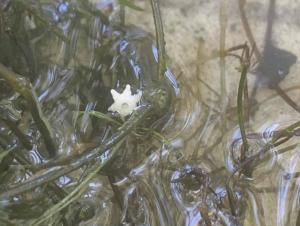

Image caption: An example of the six-pointed star shaped bulbil found on stems of Starry stonewort. (Photo credit: Kylie Wirebach)
In late September, Alex Krest, graduate student in Dr. Pennuto’s lab, began his starry thesis work in Burnt Ship Creek within Buckhorn Island State Park. No, he wasn’t observing the vastness of outer space on a beautiful fall day in Grand Island. Rather, he and some lab members were delving into the expanse of the invasive macro-algae starry stonewort (Nitellopsis obtusa) that was lying just beneath the water’s surface. This relatively under-researched species was discovered in the St. Lawrence Seaway in 1978 and can now be found throughout the Great Lakes.
Native to Eurasia, starry stonewort forms dense mats along the sediment surface and brings with it a plethora of detrimental impacts, including competitive dominance over native algae and macrophytes, reduction in fish spawning activity and overall diversity loss, and restrictions on recreational activities. This species was discovered in August near the mouth of Burnt Ship Creek by WNY PRISM staff. It is the second known infestation in Western New York and the first in Erie County. Starry stonewort has the potential wreak havoc on the region’s ecological, economic, and recreational sectors if left unchecked. Fortunately, only male plants have been observed in the Great Lakes region so far. This means that no sexual reproduction is occurring to aid population expansions, and that bulbils and plant fragment are the only means for expanding distributions. Before initiating any management activity on this population, the lab will seek to understand some basic biology of the species.
After mapping out the existing population, preliminary vegetation and invertebrate samples were collected from three patch types: starry stonewort (invasive macro-algae), muskgrass (Chara sp.) (native macro-algae), and american elodea (Elodea canadensis) (native macrophyte), to understand how starry stonewort interacts with its environment when compared to native alternatives. Ongoing research will investigate potential consumers of stonewort as well as document changes in habitat functioning associated with this invasion.
Some content on this page is saved in PDF format. To view these files, download Adobe Acrobat Reader free. If you are having trouble reading a document, request an accessible copy of the PDF or Word Document.
